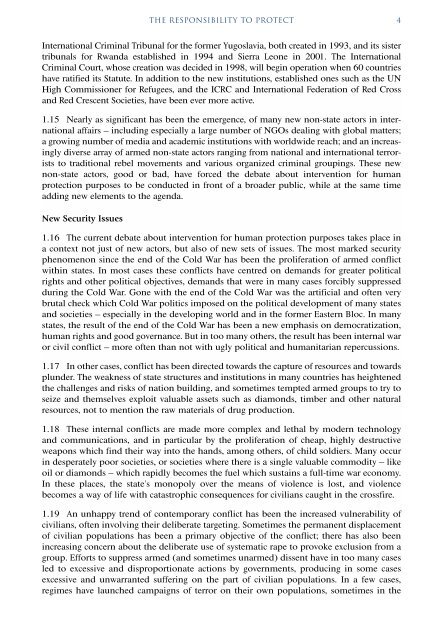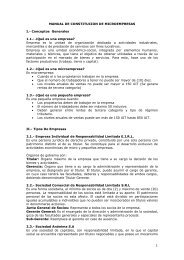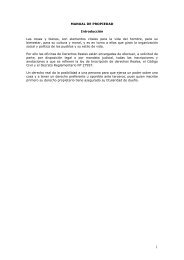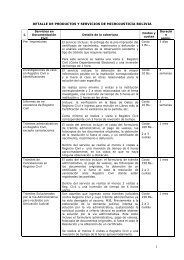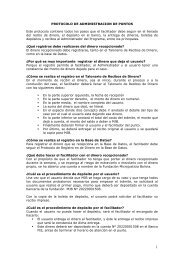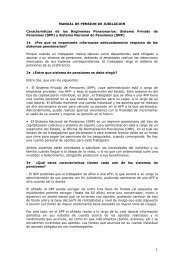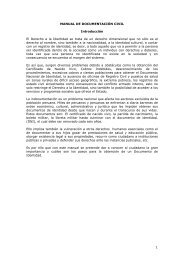ICISS report - International Coalition for the Responsibility to Protect
ICISS report - International Coalition for the Responsibility to Protect
ICISS report - International Coalition for the Responsibility to Protect
You also want an ePaper? Increase the reach of your titles
YUMPU automatically turns print PDFs into web optimized ePapers that Google loves.
The <strong>Responsibility</strong> <strong>to</strong> <strong>Protect</strong> 4<br />
<strong>International</strong> Criminal Tribunal <strong>for</strong> <strong>the</strong> <strong>for</strong>mer Yugoslavia, both created in 1993, and its sister<br />
tribunals <strong>for</strong> Rwanda established in 1994 and Sierra Leone in 2001. The <strong>International</strong><br />
Criminal Court, whose creation was decided in 1998, will begin operation when 60 countries<br />
have ratified its Statute. In addition <strong>to</strong> <strong>the</strong> new institutions, established ones such as <strong>the</strong> UN<br />
High Commissioner <strong>for</strong> Refugees, and <strong>the</strong> ICRC and <strong>International</strong> Federation of Red Cross<br />
and Red Crescent Societies, have been ever more active.<br />
1.15 Nearly as significant has been <strong>the</strong> emergence, of many new non-state ac<strong>to</strong>rs in international<br />
affairs – including especially a large number of NGOs dealing with global matters;<br />
a growing number of media and academic institutions with worldwide reach; and an increasingly<br />
diverse array of armed non-state ac<strong>to</strong>rs ranging from national and international terrorists<br />
<strong>to</strong> traditional rebel movements and various organized criminal groupings. These new<br />
non-state ac<strong>to</strong>rs, good or bad, have <strong>for</strong>ced <strong>the</strong> debate about intervention <strong>for</strong> human<br />
protection purposes <strong>to</strong> be conducted in front of a broader public, while at <strong>the</strong> same time<br />
adding new elements <strong>to</strong> <strong>the</strong> agenda.<br />
New Security Issues<br />
1.16 The current debate about intervention <strong>for</strong> human protection purposes takes place in<br />
a context not just of new ac<strong>to</strong>rs, but also of new sets of issues. The most marked security<br />
phenomenon since <strong>the</strong> end of <strong>the</strong> Cold War has been <strong>the</strong> proliferation of armed conflict<br />
within states. In most cases <strong>the</strong>se conflicts have centred on demands <strong>for</strong> greater political<br />
rights and o<strong>the</strong>r political objectives, demands that were in many cases <strong>for</strong>cibly suppressed<br />
during <strong>the</strong> Cold War. Gone with <strong>the</strong> end of <strong>the</strong> Cold War was <strong>the</strong> artificial and often very<br />
brutal check which Cold War politics imposed on <strong>the</strong> political development of many states<br />
and societies – especially in <strong>the</strong> developing world and in <strong>the</strong> <strong>for</strong>mer Eastern Bloc. In many<br />
states, <strong>the</strong> result of <strong>the</strong> end of <strong>the</strong> Cold War has been a new emphasis on democratization,<br />
human rights and good governance. But in <strong>to</strong>o many o<strong>the</strong>rs, <strong>the</strong> result has been internal war<br />
or civil conflict – more often than not with ugly political and humanitarian repercussions.<br />
1.17 In o<strong>the</strong>r cases, conflict has been directed <strong>to</strong>wards <strong>the</strong> capture of resources and <strong>to</strong>wards<br />
plunder. The weakness of state structures and institutions in many countries has heightened<br />
<strong>the</strong> challenges and risks of nation building, and sometimes tempted armed groups <strong>to</strong> try <strong>to</strong><br />
seize and <strong>the</strong>mselves exploit valuable assets such as diamonds, timber and o<strong>the</strong>r natural<br />
resources, not <strong>to</strong> mention <strong>the</strong> raw materials of drug production.<br />
1.18 These internal conflicts are made more complex and lethal by modern technology<br />
and communications, and in particular by <strong>the</strong> proliferation of cheap, highly destructive<br />
weapons which find <strong>the</strong>ir way in<strong>to</strong> <strong>the</strong> hands, among o<strong>the</strong>rs, of child soldiers. Many occur<br />
in desperately poor societies, or societies where <strong>the</strong>re is a single valuable commodity – like<br />
oil or diamonds – which rapidly becomes <strong>the</strong> fuel which sustains a full-time war economy.<br />
In <strong>the</strong>se places, <strong>the</strong> state’s monopoly over <strong>the</strong> means of violence is lost, and violence<br />
becomes a way of life with catastrophic consequences <strong>for</strong> civilians caught in <strong>the</strong> crossfire.<br />
1.19 An unhappy trend of contemporary conflict has been <strong>the</strong> increased vulnerability of<br />
civilians, often involving <strong>the</strong>ir deliberate targeting. Sometimes <strong>the</strong> permanent displacement<br />
of civilian populations has been a primary objective of <strong>the</strong> conflict; <strong>the</strong>re has also been<br />
increasing concern about <strong>the</strong> deliberate use of systematic rape <strong>to</strong> provoke exclusion from a<br />
group. Ef<strong>for</strong>ts <strong>to</strong> suppress armed (and sometimes unarmed) dissent have in <strong>to</strong>o many cases<br />
led <strong>to</strong> excessive and disproportionate actions by governments, producing in some cases<br />
excessive and unwarranted suffering on <strong>the</strong> part of civilian populations. In a few cases,<br />
regimes have launched campaigns of terror on <strong>the</strong>ir own populations, sometimes in <strong>the</strong>


